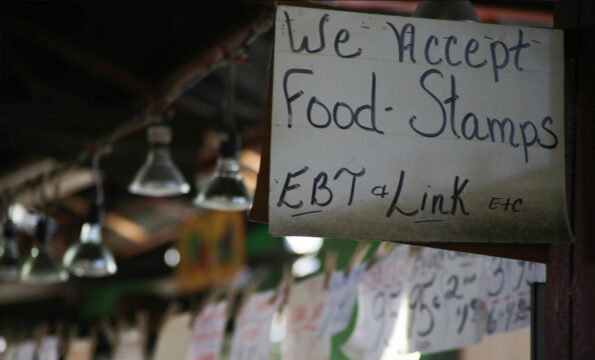CNN, por Tami Luhby: Los beneficiarios de los cupones de alimentos verán aumentar sus pagos mensuales en octubre gracias a una importante actualización del programa, a pesar de que la ayuda especial para la pandemia ya ha expirado.
Las prestaciones aumentarán un 27% por encima de los niveles anteriores a la pandemia, lo que supone el mayor incremento de la historia. El cambio se debe a una revisión del Plan de Alimentos Ahorrativos, que determina los importes de las prestaciones del Programa de Asistencia Nutricional Suplementaria, o SNAP, el nombre formal de los cupones de alimentos.
La actualización se produce como parte de una revisión del Departamento de Agricultura de los Estados Unidos del programa de cupones de alimentos requerida por la Ley Agrícola de 2018. El entonces Congreso liderado por los republicanos ordenó a la agencia reevaluar el plan para el año fiscal 2022 – y cada cinco años a partir de entonces. La última vez que se ajustó fue en 2006.
Con la revisión, que es permanente, los beneficiarios verán un aumento de 36 dólares en las prestaciones mensuales medias. Antes de la pandemia de coronavirus recibían 121 dólares por persona.
Incluyendo el ajuste anual del coste de la vida, que se basa en la inflación de los precios de los alimentos y se aplica cada octubre, la prestación mensual media ascenderá a 169 dólares por persona, según la agencia.
Sin embargo, los beneficiarios recibirán en realidad más que eso porque uno de los programas de ayuda para la pandemia del Congreso sigue en vigor en la mayoría de los estados, aunque el aumento del 15% terminó el 30 de septiembre. Los legisladores también aumentaron la asignación mensual de cupones de alimentos de los inscritos hasta la cantidad máxima para el tamaño de su familia durante la pandemia, una medida que el presidente Joe Biden extendió a principios de este año a otros 25 millones de personas en hogares de muy bajos ingresos que originalmente no recibieron los beneficios adicionales.
Teniendo en cuenta esto, los beneficiarios recibirán 251 dólares por persona, de media. Más de 42,3 millones de personas estaban inscritas en el programa en junio, frente a los casi 37 millones de febrero de 2020.
La idoneidad de las prestaciones de los cupones de alimentos ha sido durante mucho tiempo una cuestión. Los defensores de los estadounidenses con bajos ingresos argumentan que los fondos se agotan antes de que termine el mes. Pero los expertos conservadores señalan que el programa está diseñado para complementar el presupuesto de alimentos de una familia.
Los defensores de la izquierda han dicho durante años que el Plan de Alimentos Ahorrativos, que se introdujo en 1975, está anticuado. Se basa en suposiciones poco realistas sobre la asequibilidad y disponibilidad de los alimentos hoy en día, así como sobre el tiempo que tienen las familias para comprar y preparar las comidas, argumentan.
«Realmente no hemos revisado los supuestos subyacentes desde los años 70, lo cual es un poco horrible dado lo diferente que es el modo en que comemos, el precio de los alimentos, la forma en que las familias adquieren y preparan los alimentos», dijo Elaine Waxman, investigadora principal del Instituto Urbano. «Todas estas cosas han cambiado mucho. Así que esto llega con mucho retraso».
El coste medio de una comida en EE.UU. es de 2,41 dólares, un 22% más alto que las prestaciones máximas de los cupones de alimentos, según un reciente informe del Urban Institute del que Waxman es coautor. En 2020, la prestación máxima no cubría el coste de una comida de precio modesto en el 96% de los condados estadounidenses. La revisión, sin embargo, reducirá esa cifra a un estimado 21% de los condados.
Aun así, algunos defensores sostienen que hay que hacer más.
«El Plan de Alimentación Ahorrativa sigue siendo realmente el mínimo. ¿Cuál es la menor cantidad de dinero que una familia con dificultades tendría que gastar para tener una dieta saludable?», dijo Lisa Davis, vicepresidenta senior de Share Our Strength, que busca acabar con el hambre y la pobreza infantil.
«No es generoso ni mucho menos», añadió. «Este es un paso muy importante hacia la adecuación de las prestaciones del SNAP, pero aún no hemos llegado a ese punto».
Nuestro comentario:
¿Se están convirtiendo las condiciones en algo similar a la Francia de antes de la revolución? ¿Está la nación decayendo gradualmente?
Conexión Profética:
“Con la huída de los hugonotes quedó Francia sumida en general decadencia. Florecientes ciudades manufactureras quedaron arruinadas; los distritos más fértiles volvieron a quedar baldíos, el entorpecimiento intelectual y el decaimiento de la moralidad sucedieron al notable progreso que antes imperara. París quedó convertido en un vasto asilo: asegúrase que precisamente antes de estallar la Revolución doscientos mil indigentes dependían de los socorros del rey. Únicamente los jesuítas prosperaban en la nación decaída, y gobernaban con infame tiranía sobre las iglesias y las escuelas, las cárceles y las galeras.” El Conflicto de los Siglos, pág. 322.






Comments